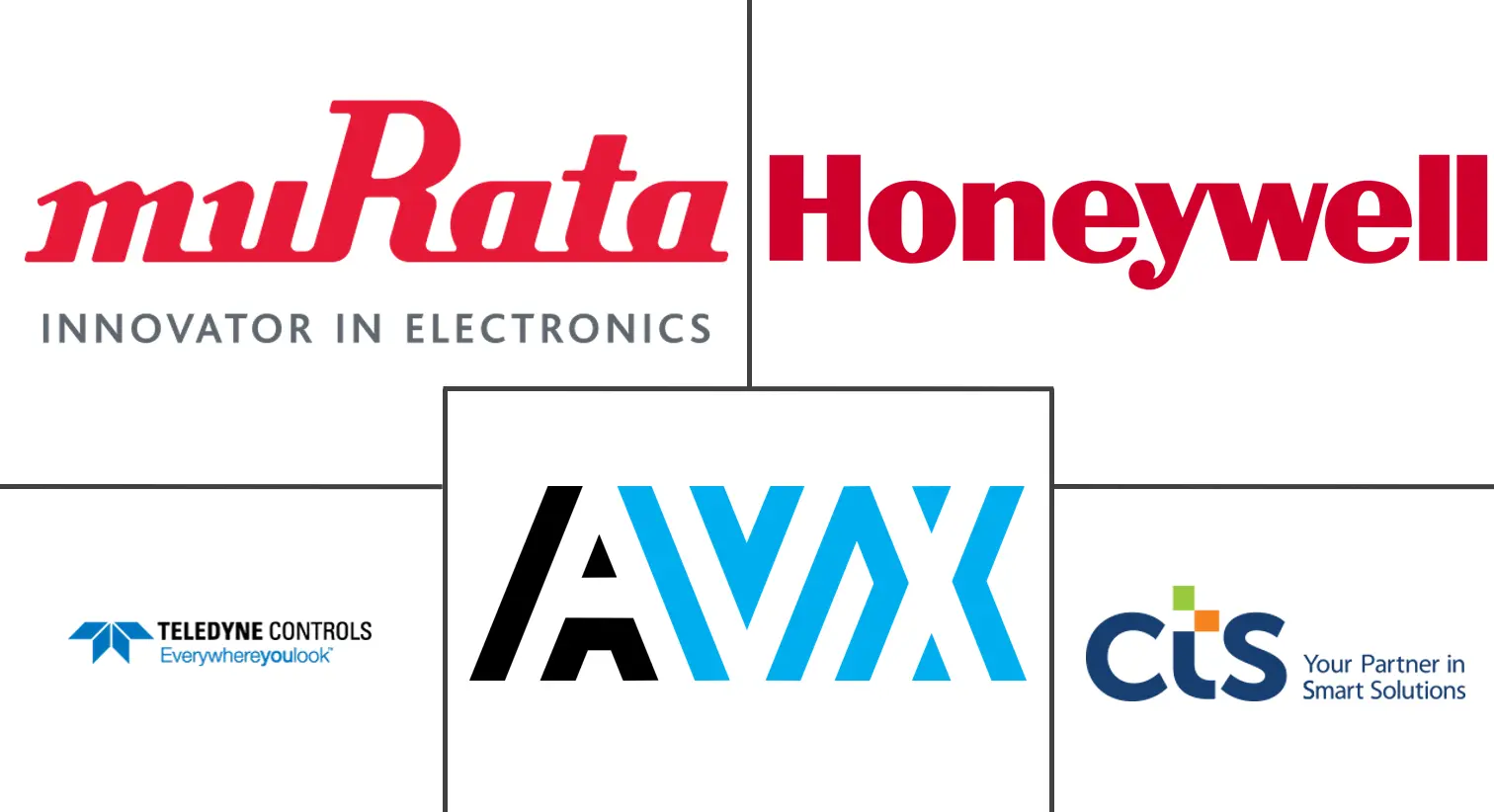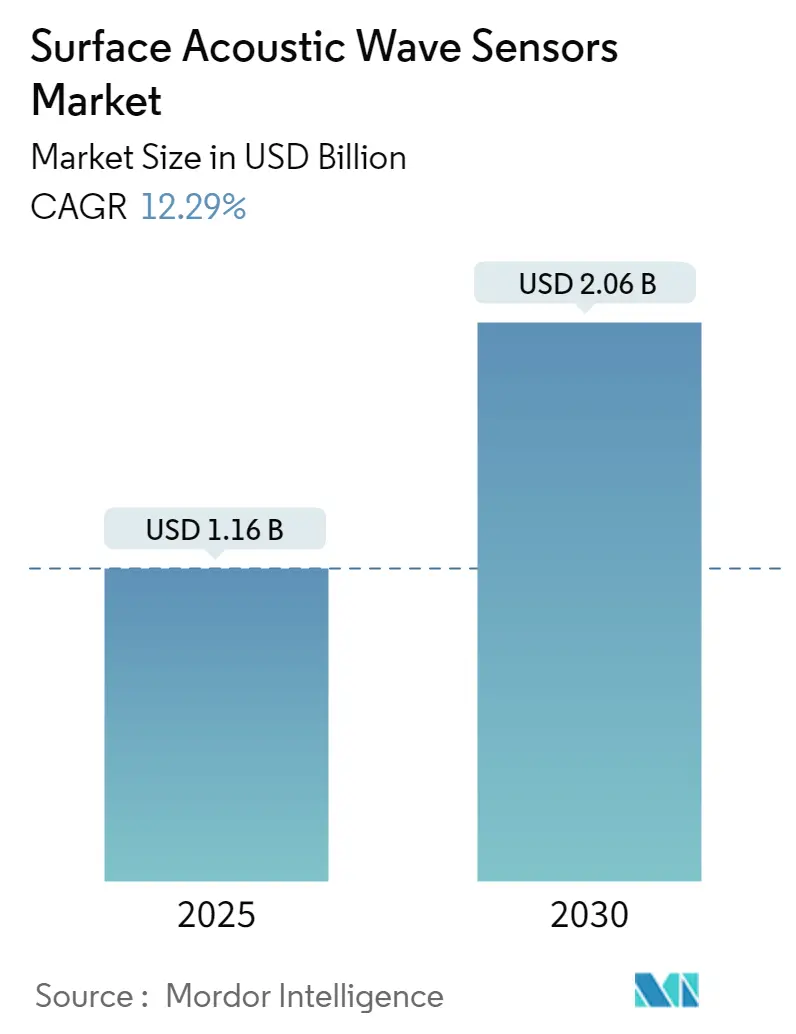
Surface Acoustic Wave Sensors Market Analysis
The Surface Acoustic Wave Sensors Market size is estimated at USD 1.16 billion in 2025, and is expected to reach USD 2.06 billion by 2030, at a CAGR of 12.29% during the forecast period (2025-2030).
The surface acoustic wave sensors market is experiencing significant transformation driven by the rapid advancement of automotive technologies and electric vehicle adoption. The integration of SAW sensors in modern vehicles has become crucial for applications ranging from tire pressure monitoring to torque measurement in electric powertrains. According to UBS projections, the global market for sensor semiconductors in autonomous vehicles is expected to reach USD 30 billion by 2030, highlighting the growing importance of advanced sensing technologies. The automotive industry's shift toward electric and autonomous vehicles has particularly accelerated the demand for SAW sensors, as these devices offer unique advantages in measuring various parameters on rotating components while remaining immune to electromagnetic interference.
The aerospace and defense sector continues to be a major growth catalyst for SAW sensor technology, with increasing investments in electronic warfare systems and advanced radar applications. Acoustic wave sensors are being extensively utilized in military radar and electronic warfare system designs as an alternative to traditional components, offering superior performance in high-frequency applications. The technology's ability to operate in harsh environments and over wide temperature ranges, combined with its inherent radiation hardening properties, has made it particularly attractive for aerospace applications, including satellite communications and rocket propulsion systems.
The telecommunications infrastructure sector is witnessing a revolutionary transformation with the ongoing deployment of 5G networks, creating substantial opportunities for acoustic wave sensor applications. According to GSMA, mobile operators in the Asia-Pacific region are expected to invest over USD 400 billion in their networks between 2020 and 2025, with a significant portion allocated to 5G deployments. Surface acoustic wave sensors have become essential components in modern wireless communication systems, particularly in 5G infrastructure, where they play a crucial role in signal processing and frequency filtering applications.
The industrial sector is increasingly adopting wave sensors technology for various applications, from structural health monitoring to chemical detection systems. These sensors are being integrated into industrial automation systems for real-time monitoring of pressure, temperature, and chemical parameters, contributing to enhanced operational efficiency and safety. The technology's passive wireless nature and ability to operate in challenging industrial environments have made it particularly valuable for applications in renewable energy systems, power equipment monitoring, and industrial process control. The growing trend of industrial digitalization and the Internet of Things (IoT) has further expanded the application scope of the acoustic sensors market in smart manufacturing and predictive maintenance systems.
Surface Acoustic Wave Sensors Market Trends
Wireless and Passive Nature of Sensors
The wireless and passive characteristics of surface acoustic wave sensors represent a major technological advantage driving their widespread adoption across industries. These wave sensors require no power source and fulfill their energy requirements solely from the interrogating RF pulse used to excite the surface acoustic wave and transmit its response, making them ideal for applications where wired sensors are impractical or impossible to implement. The ability to measure various parameters such as pressure, temperature, and torque on rotating components while being well-protected from electromagnetic interference in industrial environments like motors and high-voltage lines makes these sensors particularly valuable for power equipment applications. Their insensitivity to magnetic fields further enhances their suitability for automotive applications requiring torque sensing near electric motors and solenoids.
The advancement in RF communication has significantly expanded the capabilities of SAW devices in complex RF communication techniques, including frequency modulated continuous wave and orthogonal frequency coding. These sensors are finding widespread applications as filters in communication systems and as physical, chemical, and bio-sensors and ID tags, with the passive wireless SAW sensing system primarily consisting of a passive SAW sensor and an interrogation unit that processes the sensor response. The technology's wireless nature has also enabled its integration into miniaturized devices for healthcare applications, such as monitoring chest sounds in neonatal care units where the small size minimizes patient discomfort, and in developing wearable biosensors for various medical monitoring applications.
Low Manufacturing Cost
The cost-effectiveness of SAW sensor components and devices has emerged as a significant growth driver, offering unique characteristics that cannot be found in purely electronic components while maintaining high-performance levels. The manufacturing process benefits from relatively simple composition and widespread adoption in consumer electronics, particularly in the smartphone industry, which has led to dramatic reductions in material costs over the past three decades. This is evidenced by the remarkable decrease in wafer costs, which have dropped from approximately USD 1,000 in the 1990s to around USD 50 in recent years, making these sensors increasingly accessible for various applications.
Recent advancements in additive manufacturing techniques, printed electronics, and nanomaterials have further enhanced the cost-effective fabrication of surface acoustic wave sensors and systems. The emergence of new conductive printing technologies has created opportunities for more efficient and economical fabrication of custom SAW devices, attracting more end-users to the market. Companies are increasingly utilizing piezoelectric on insulator (POI) substrates to achieve overall low-cost devices while maintaining high performance. The absence of batteries in these sensors results in smaller sizes, and the batch manufacturing strategy enables their use as disposable sensors, making them particularly attractive for applications requiring frequent replacement or one-time use scenarios. This combination of low manufacturing costs and high performance has made surface acoustic wave sensor increasingly competitive against alternative sensing technologies, particularly in applications requiring wireless and passive operation.
Segment Analysis: By Sensing Type
Pressure Sensors Segment in Surface Acoustic Wave Sensors Market
The pressure sensors segment continues to dominate the global surface acoustic wave sensors market, holding approximately 21% market share in 2024. This significant market position is driven by the extensive adoption of SAW sensors across various industries, particularly in automotive applications for tire pressure monitoring systems (TPMS). The segment's growth is further bolstered by increasing applications in industrial process control, aerospace systems, and healthcare equipment. Surface acoustic wave pressure sensors are particularly valued for their passive nature and remote sensing capabilities, making them ideal for deployment in small enclosures and challenging environments. Their wireless operation and ability to function without direct power sources have made them increasingly popular in modern automotive designs and industrial automation systems.
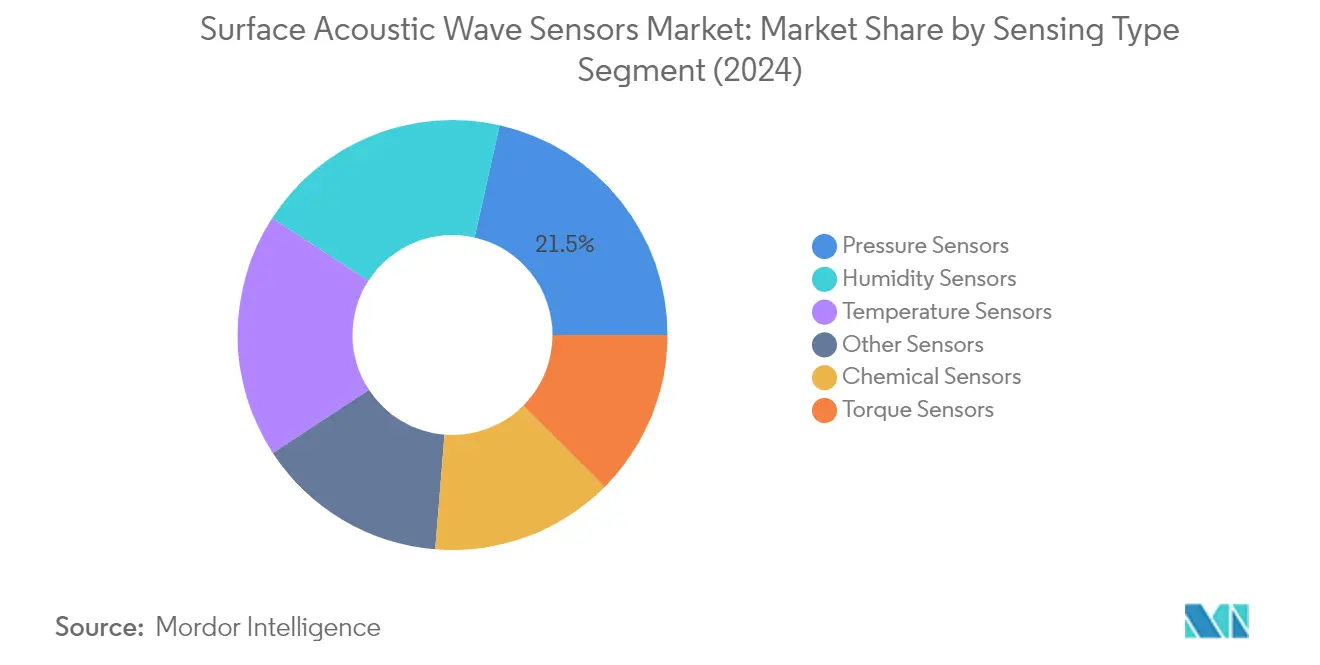
Humidity Sensors Segment in Surface Acoustic Wave Sensors Market
The humidity sensors segment is emerging as the fastest-growing category in the surface acoustic wave sensors market, with an expected growth rate of approximately 14% during 2024-2029. This remarkable growth is primarily attributed to the increasing adoption of these sensors in consumer electronics, smart homes, and IoT devices. The segment's expansion is driven by technological advancements in graphene-based SAW humidity sensors, which offer superior performance characteristics including good reversibility, excellent short-term repeatability, and enhanced stability. These sensors are gaining significant traction in meteorology, agriculture, automotive, medical, HVAC, and manufacturing industries due to their high precision and reliability in humidity detection applications.
Remaining Segments in Surface Acoustic Wave Sensors Market
The surface acoustic wave sensors market encompasses several other significant segments, including temperature sensors, torque sensors, chemical sensors, and other specialized sensors. Temperature sensors are crucial in industrial and aerospace applications, offering high precision in extreme conditions. Torque sensors have found extensive applications in automotive and industrial machinery for precise measurement and control. Chemical sensors are increasingly being utilized in environmental monitoring and industrial process control. The remaining specialized sensors cater to specific applications such as mass sensing, biosensing, and film thickness measurement, contributing to the market's diverse application portfolio and technological advancement.
Segment Analysis: By End-User Industries
Consumer Electronics Segment in Surface Acoustic Wave Sensors Market
The consumer electronics segment maintains its dominant position in the surface acoustic wave sensors market, commanding approximately 30% of the total market share in 2024. This significant market presence is primarily driven by the extensive adoption of SAW sensors in smartphones, tablets, and other consumer electronic devices, particularly in RF filters and signal processing applications. The segment's growth is further bolstered by the increasing deployment of 5G technology, where SAW filters offer superior performance in the sub-2.7 GHz frequency range. The integration of SAW technology in touchscreens, wearables, and IoT devices has also contributed substantially to the segment's market leadership, with manufacturers leveraging the technology's advantages in providing small form factors and improved power handling capabilities.
Automotive Segment in Surface Acoustic Wave Sensors Market
The automotive segment is emerging as the fastest-growing sector in the surface acoustic wave sensors market, with projections indicating robust growth of approximately 14% during the forecast period 2024-2029. This exceptional growth trajectory is driven by the increasing integration of SAW sensors in various automotive applications, including tire pressure monitoring systems (TPMS), torque sensors, and temperature monitoring systems. The segment's rapid expansion is further fueled by the growing adoption of electric vehicles and autonomous driving technologies, where SAW sensors play crucial roles in ensuring precise measurements and enhanced safety features. The automotive industry's focus on developing more sophisticated driver assistance systems and the mandate for advanced safety features in vehicles across various regions continue to drive the demand for SAW sensors in this segment.
Remaining Segments in End-User Industries
The industrial, healthcare, and aerospace & defense segments, along with other miscellaneous applications, constitute significant portions of the surface acoustic wave sensors market. The industrial sector leverages SAW sensors for automation, process control, and environmental monitoring applications. The healthcare segment utilizes these sensors in medical devices and diagnostic equipment, while the aerospace & defense sector employs them in radar systems and electronic warfare applications. Each of these segments contributes uniquely to the market's diversity, with applications ranging from structural health monitoring in industrial settings to biosensors in healthcare and advanced communication systems in defense applications. The versatility and reliability of SAW sensors continue to drive their adoption across these varied sectors, ensuring sustained market growth.
Surface Acoustic Wave Sensors Market Geography Segment Analysis
Surface Acoustic Wave Sensors Market in North America
North America represents a significant market for surface acoustic wave sensors, accounting for approximately 24% of the global market share in 2024. The region's dominance is primarily attributed to its strong technological infrastructure and the presence of major market vendors who provide an upper hand in product innovation and technological advancement. The market is characterized by high technological awareness among end-user consumers and intense competition among local equipment manufacturers. The region demonstrates particular strength in sectors such as automotive, aerospace, healthcare, consumer electronics, and industrial applications, where SAW sensors are increasingly being adopted. The robust semiconductor industry, coupled with continuous innovation in manufacturing, design, and research activities, further solidifies North America's position in the global surface acoustic wave sensors market. The region's focus on advanced technologies and adoption of low-cost components continues to expand the scope of SAW sensors, particularly in emerging applications such as IoT devices and smart manufacturing solutions.
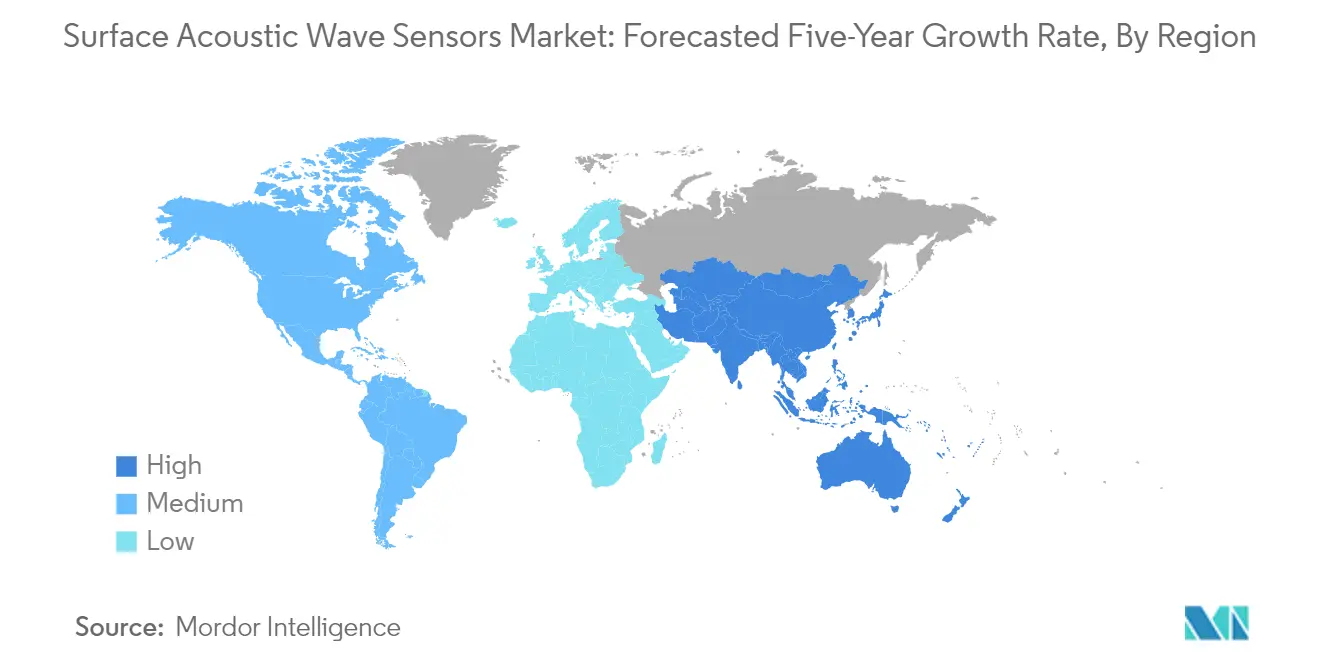
Surface Acoustic Wave Sensors Market in Europe
Europe has established itself as a crucial market for surface acoustic wave sensors, demonstrating remarkable growth of approximately 51% during the period 2019-2024. The region's market is characterized by the strong presence of prominent acoustic wave sensor manufacturers and highly advanced end-user industries. European manufacturers are particularly notable for their expertise in automotive applications, especially in electric vehicle manufacturing, which has become a significant driver for SAW sensor adoption. The region's market is further strengthened by its robust aerospace and defense sector, where SAW sensors find extensive applications in electronic warfare systems and advanced military equipment. The market also benefits from the region's strong focus on research and development activities, particularly in areas such as chemical sensing applications and RF filter technologies. European manufacturers continue to maintain their competitive edge through continuous innovation and strategic partnerships, especially in emerging applications such as industrial automation and smart city initiatives.
Surface Acoustic Wave Sensors Market in Asia-Pacific
The Asia-Pacific region stands as the largest and most dynamic market for surface acoustic wave sensors, with projections indicating a robust growth rate of approximately 12% during the period 2024-2029. The region's dominance is underpinned by its leadership in global semiconductor manufacturing and its position as a major hub for consumer electronics, electric vehicles, and advanced electronic devices production. Countries like China, Japan, Taiwan, and South Korea serve as primary manufacturing centers, while emerging economies such as India, Vietnam, Thailand, Malaysia, and Singapore contribute significantly to the market's expansion. The region's market is characterized by its competitive pricing strategies, particularly among Chinese vendors who leverage cost advantages to gain market share. The rapid industrialization, coupled with increasing adoption of sensor technologies for precise sensing solutions, continues to drive market growth. The region's strong focus on technological advancement, particularly in telecommunications and automotive sectors, positions it as a crucial market for SAW sensors applications.
Surface Acoustic Wave Sensors Market in Rest of the World
The Rest of the World market, comprising Latin America and the Middle East & Africa, represents an emerging opportunity for wave sensors. The market in these regions is primarily driven by advancements in the telecom industry and growing investments in infrastructure development. The Middle East, particularly the GCC countries, shows promising growth potential due to their increasing focus on smart city initiatives and industrial automation projects. Latin American countries are witnessing growing adoption in automotive manufacturing and consumer electronics sectors. The healthcare industry in these regions is also advancing, creating opportunities for SAW sensor applications in medical devices and monitoring systems. The market is further supported by increasing investments in defense and aerospace sectors, particularly in countries focusing on modernizing their military capabilities. The gradual expansion of manufacturing capabilities and increasing awareness of advanced sensing technologies continue to drive the adoption of SAW sensors in these regions.
Surface Acoustic Wave Sensors Industry Overview
Top Companies in Surface Acoustic Wave Sensors Market
The surface acoustic wave sensors market is characterized by companies focusing heavily on research and development to drive product innovation, particularly in areas like RF filters, automotive applications, and wireless communication technologies. Companies are pursuing strategic partnerships and joint ventures, especially in emerging technologies like 5G infrastructure and IoT applications, to strengthen their market positions. Operational agility is demonstrated through investments in advanced manufacturing capabilities and the development of custom solutions for specific industry applications. Market leaders are expanding their geographical presence through distribution agreements and strategic acquisitions, particularly in high-growth regions like Asia-Pacific. Product development strategies are increasingly centered around miniaturization, improved performance characteristics, and cost-effective manufacturing processes to meet evolving customer demands across various industries.
Consolidated Market Led By Global Conglomerates
The surface acoustic wave sensors market exhibits a relatively consolidated structure dominated by large multinational conglomerates with diverse product portfolios spanning multiple electronic component categories. These established players leverage their extensive manufacturing capabilities, strong distribution networks, and significant research and development resources to maintain their market positions. The market has witnessed several notable mergers and acquisitions, particularly involving companies seeking to enhance their technological capabilities in areas such as RF filtering and acoustic wave sensor applications. Many of these consolidation activities are driven by the need to acquire specialized expertise in emerging applications and access to new geographical markets.
The competitive landscape is characterized by the presence of both diversified electronics manufacturers and specialized sensor technology providers. While global conglomerates maintain their dominance through integrated solutions and broad market coverage, specialized players have carved out niches in specific applications or technologies. The market has seen increased collaboration between established players and technology startups, particularly in developing advanced sensing solutions for emerging applications in automotive, healthcare, and industrial sectors. Regional players, especially in Asia, are gaining prominence through cost-competitive offerings and strong local market understanding.
Innovation and Customization Drive Market Success
Success in the surface acoustic wave sensors market increasingly depends on companies' ability to develop innovative solutions that address specific industry challenges while maintaining cost competitiveness. Market leaders are focusing on developing customized solutions for high-growth applications in automotive, telecommunications, and industrial automation sectors. The ability to provide comprehensive technical support, rapid prototyping capabilities, and flexible manufacturing processes has become crucial for maintaining customer relationships and gaining market share. Companies are also investing in developing more robust supply chain networks and establishing strategic partnerships with key component suppliers to ensure consistent product quality and timely delivery.
Future market success will be significantly influenced by companies' ability to navigate technological transitions, particularly in emerging applications like 5G communications and IoT devices. Players must balance the need for standardization with increasing demands for customized solutions while managing potential substitution risks from alternative technologies. Regulatory compliance, particularly in sensitive applications like medical devices and automotive safety systems, is becoming increasingly important for market participation. Companies that can effectively combine technological innovation with strong customer relationships and efficient operations while maintaining competitive pricing are likely to gain competitive advantages in this evolving wave sensors market landscape.
Surface Acoustic Wave Sensors Market Leaders
-
Honeywell International Inc.
-
Murata Manufacturing Co., Ltd.
-
AVX Corporation
-
CTS Corporation
-
Teledyne Microwave Solutions
- *Disclaimer: Major Players sorted in no particular order
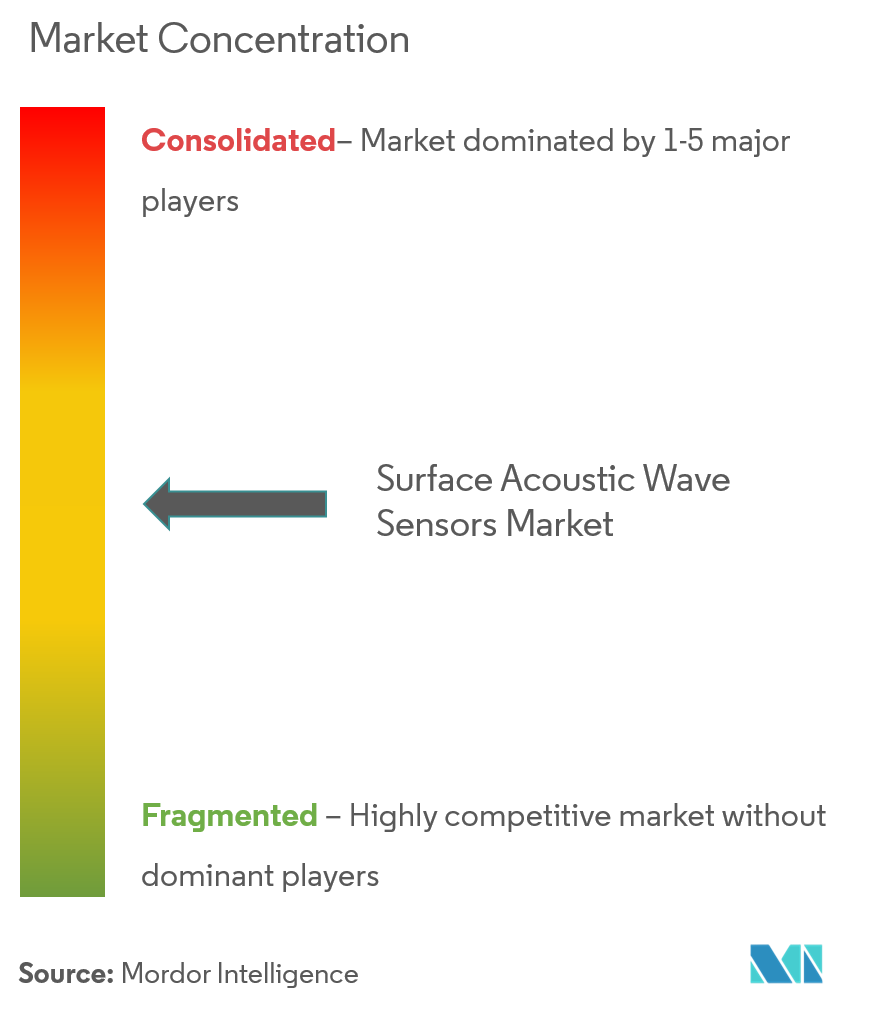
Surface Acoustic Wave Sensors Market News
- May 2021 - Sensor Technology has launched a new range of wireless torque sensors based on a full four-element strain gauge bridge design, complementing its existing non-contact sensors that use surface acoustic wave (SAW) detection. The SGR510/520 series design also compensates for any extraneous forces, such as bending moments that are inadvertently applied to the sensor, which improves sensitivity and has a wide temperature tolerance. The units have a 250% over-range reading capacity, allowing sudden spikes in torque to be measured and recorded accurately.
- April 2021 - Okmetic, the supplier of advanced silicon wafers for the manufacture of microelectromechanical systems and sensors, announced the release of UF-RFSi, a tailored silicon substrate dedicated to thin-film surface acoustic wave (TF-SAW) hybrid structures.
Surface Acoustic Wave Sensors Market Report - Table of Contents
1. INTRODUCTION
- 1.1 Study Assumptions and Market Definition
- 1.2 Scope of the Study
2. RESEARCH METHODOLOGY
3. EXECUTIVE SUMMARY
4. MARKET DYNAMICS
- 4.1 Market Overview
-
4.2 Market Drivers
- 4.2.1 Wireless and Passive Nature of Sensors
- 4.2.2 Low Manufacturing Cost
-
4.3 Market Restraints
- 4.3.1 Compatibility and Installation Issues
- 4.3.2 Limitations in Liquid Sensing
-
4.4 Industry Attractiveness - Porter's Five Forces Analysis
- 4.4.1 Threat of New Entrants
- 4.4.2 Bargaining Power of Buyers
- 4.4.3 Bargaining Power of Suppliers
- 4.4.4 Threat of Substitute Products
- 4.4.5 Intensity of Competitive Rivalry
5. MARKET SEGMENTATION
-
5.1 Sensing Type
- 5.1.1 Pressure Sensors
- 5.1.2 Torque Sensors
- 5.1.3 Temperature Sensors
- 5.1.4 Humidity Sensors
- 5.1.5 Chemical Sensors
- 5.1.6 Other Sensors
-
5.2 End-User Industry
- 5.2.1 Automotive
- 5.2.2 Aerospace and Defense
- 5.2.3 Consumer Electronics
- 5.2.4 Healthcare
- 5.2.5 Industrial
- 5.2.6 Other End-User Industries
-
5.3 Geography
- 5.3.1 North America
- 5.3.2 Europe
- 5.3.3 Asia Pacific
- 5.3.4 Rest of the World
6. COMPETITIVE LANDSCAPE
-
6.1 Company Profiles
- 6.1.1 API Technologies Corp.
- 6.1.2 Vectron International (Microchip Technology Inc.)
- 6.1.3 AVX Corporation
- 6.1.4 Boston Piezo-Optics Inc.
- 6.1.5 Ceramtec
- 6.1.6 CTS Corporation
- 6.1.7 TDK Electronics AG
- 6.1.8 Honeywell International Inc
- 6.1.9 Teledyne Microwave Solutions
- 6.1.10 Murata Manufacturing Co., Ltd.
- *List Not Exhaustive
7. INVESTMENT ANALYSIS
8. FUTURE OF THE MARKET
Surface Acoustic Wave Sensors Industry Segmentation
Surface acoustic wave (SAW) sensors are primarily used for the identification and measurement of physical parameters such as pressure, temperature, acceleration, torque, tire-road friction, humidity, etc. These sensors are used in various end-user industries based on the requirements.
The Surface Acoustic Wave Sensors Market is segmented by Sensing Type (Pressure Sensors, Torque Sensors, Viscosity Sensors), End-user Industry (Automotive, Consumer Electronics, Industrial), and Geography.
| Sensing Type | Pressure Sensors |
| Torque Sensors | |
| Temperature Sensors | |
| Humidity Sensors | |
| Chemical Sensors | |
| Other Sensors | |
| End-User Industry | Automotive |
| Aerospace and Defense | |
| Consumer Electronics | |
| Healthcare | |
| Industrial | |
| Other End-User Industries | |
| Geography | North America |
| Europe | |
| Asia Pacific | |
| Rest of the World |
Surface Acoustic Wave Sensors Market Research FAQs
How big is the Surface Acoustic Wave Sensors Market?
The Surface Acoustic Wave Sensors Market size is expected to reach USD 1.16 billion in 2025 and grow at a CAGR of 12.29% to reach USD 2.06 billion by 2030.
What is the current Surface Acoustic Wave Sensors Market size?
In 2025, the Surface Acoustic Wave Sensors Market size is expected to reach USD 1.16 billion.
Who are the key players in Surface Acoustic Wave Sensors Market?
Honeywell International Inc., Murata Manufacturing Co., Ltd., AVX Corporation, CTS Corporation and Teledyne Microwave Solutions are the major companies operating in the Surface Acoustic Wave Sensors Market.
Which is the fastest growing region in Surface Acoustic Wave Sensors Market?
North America is estimated to grow at the highest CAGR over the forecast period (2025-2030).
Which region has the biggest share in Surface Acoustic Wave Sensors Market?
In 2025, the Asia Pacific accounts for the largest market share in Surface Acoustic Wave Sensors Market.
What years does this Surface Acoustic Wave Sensors Market cover, and what was the market size in 2024?
In 2024, the Surface Acoustic Wave Sensors Market size was estimated at USD 1.02 billion. The report covers the Surface Acoustic Wave Sensors Market historical market size for years: 2019, 2020, 2021, 2022, 2023 and 2024. The report also forecasts the Surface Acoustic Wave Sensors Market size for years: 2025, 2026, 2027, 2028, 2029 and 2030.
Our Best Selling Reports
Surface Acoustic Wave Sensors Market Research
Mordor Intelligence provides a comprehensive analysis of the surface acoustic wave sensor market, drawing on our extensive experience in technical research and consulting. Our latest report explores the evolving landscape of SAW sensors and acoustic wave sensor technologies. It includes a detailed examination of acoustic sensors and advanced surface acoustic wave sensor applications. The report, available as an easy-to-download PDF, covers everything from basic wave sensors to sophisticated SAW components and acoustic surface filters.
Our analysis offers stakeholders crucial insights into surface acoustic wave sensors applications. This includes surface acoustic wave touch screen implementations and emerging surface strain sensor technologies. The report investigates SAW oscillators and their impact on industry development. It also provides detailed information about acoustic wave sensors pricing trends and market dynamics. Stakeholders benefit from our thorough examination of waveform monitor technologies and wave make device innovations. This is supported by extensive technical documentation and interviews with industry experts. The comprehensive report PDF download includes a detailed analysis of surface acoustic wave SAW hardware applications and future technological trajectories.

